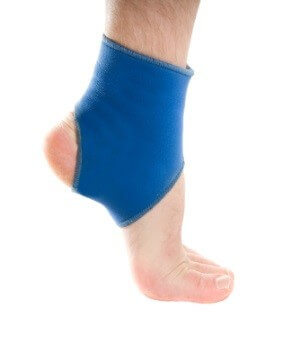





 According to running shoe experts, finding the right running shoes can be tricky. What’s important is making sure you know what type of shoes your feet require. When buying a newer version of shoes you want to replace, make sure that the model is exactly the same and alterations have not been made. Also opt for buying a shoe that will allow your feet more room to expand as you run. Find a qualified salesperson who will accompany your needs and recommend running shoes that are neutral and comfortable for your feet. Be mindful of the durability of each pair of shoes, as a pair of typical running shoes can last “on average 350-500 miles.” This can vary per person, but it’s important to know when your shoes need to be replaced.
According to running shoe experts, finding the right running shoes can be tricky. What’s important is making sure you know what type of shoes your feet require. When buying a newer version of shoes you want to replace, make sure that the model is exactly the same and alterations have not been made. Also opt for buying a shoe that will allow your feet more room to expand as you run. Find a qualified salesperson who will accompany your needs and recommend running shoes that are neutral and comfortable for your feet. Be mindful of the durability of each pair of shoes, as a pair of typical running shoes can last “on average 350-500 miles.” This can vary per person, but it’s important to know when your shoes need to be replaced.
Finding a proper fitting shoe is important in reducing injuries and preventing foot problems. For more information about treatment, consult with one of our podiatrists of Active Foot and Ankle Care, LLC. Our doctors will attend to all of your podiatric needs.
Proper Shoe Fitting
A common concern when it comes to foot health, having properly fitted shoes can help prevent injuries to the foot. Out feet affect our posture and gait, which in turn affects the biomechanics and overall bodily structure. With 33 joints, 26 bones, and over 100 ligaments, the potential for serious injury is much greater than one realizes. Although the feet cease growth in adulthood, they still change shape as they mature. Here are some factors to consider when it comes to investing in proper fitting shoes:
Keeping in mind how shoes fit the biomechanics of your body, proper fitting shoes is vitally important. Fortunately, it is not difficult to acquire footwear that fits correctly. Be sure to wear shoes that support the overall structure of your body. Do your feet a favor and invest in several pairs of well-fitted shoes today.
If you have any questions please feel free to contact our offices located in New Jersey. We offer the newest diagnostic tools and technologies to treat your foot and ankle needs.
 According to a study conducted by the Journal of Foot & Ankle Surgery, those who have stress fractures were tested to have low levels of vitamin D. Vitamin D can help reduce the risk of physical injury because it is “intimately linked to the absorption of dietary calcium and phosphorus,” as written by Jason R. Miller, DPM, of Premier Orthopedics and Sports Medicine in Pennsylvania. Research suggests that those who do not get enough vitamin D will only absorb about 10% to 15% of calcium and only 50% to 60% of phosphorus, which can affect bone development and eventually, structure. Healthy levels of vitamin D should be maintained daily, as recommended by doctors.
According to a study conducted by the Journal of Foot & Ankle Surgery, those who have stress fractures were tested to have low levels of vitamin D. Vitamin D can help reduce the risk of physical injury because it is “intimately linked to the absorption of dietary calcium and phosphorus,” as written by Jason R. Miller, DPM, of Premier Orthopedics and Sports Medicine in Pennsylvania. Research suggests that those who do not get enough vitamin D will only absorb about 10% to 15% of calcium and only 50% to 60% of phosphorus, which can affect bone development and eventually, structure. Healthy levels of vitamin D should be maintained daily, as recommended by doctors.
Activities where too much pressure is put on the feet can cause stress fractures. If you have any concerns about your feet contact one of our podiatrists of Active Foot and Ankle Care, LLC. Our doctors will treat your foot and ankle needs.
Dealing with Stress Fractures of the Foot and Ankle
The Stress Fractures occur on the foot and ankle when muscles in these areas weaken from too much or too little use. Then the feet and ankles lose support when walking or running from the impact of the ground. Since there is no protection the bones receive the full impact of each step. The stress on the feet causes cracks to form in the bones, thus called stress fractures.
What are Stress Fractures?
Stress fractures occur frequently in individuals whose daily activities cause great impact on the feet and ankles. Stress factors are most common among:
-runners
-people affected with Osteoporosis
-play tennis or basketball
-gymnastics
-high impact workouts
Symptoms
Pain from the fractures occur in the area of the fractures, and can be constant or intermittent. It will often cause sharp or dull pain with swelling and tenderness. Engaging in any kind of activity which involves in high impact will aggravate pain.
If you have any questions please feel free to contact our offices located in New Jersey. We offer the newest diagnostic tools and technologies to treat your foot and ankle needs.
 This year it is important to support your feet with custom orthotics. While designed to distribute the weight of your body evenly across your feet, orthotics help those with foot deformities, athletes, pregnant mothers, and the elderly. While orthotics cannot permanently reduce the effects of foot pain, they can help slow them down and ease the pain. Custom orthotics should be checked every year, as the foot constantly changes in supportive need.
This year it is important to support your feet with custom orthotics. While designed to distribute the weight of your body evenly across your feet, orthotics help those with foot deformities, athletes, pregnant mothers, and the elderly. While orthotics cannot permanently reduce the effects of foot pain, they can help slow them down and ease the pain. Custom orthotics should be checked every year, as the foot constantly changes in supportive need.
If you are having discomfort in your feet and would like to try orthotics, contact one of our podiatrists of Active Foot and Ankle Care, LLC. Our doctors will treat your foot and ankle needs.
What are Orthotics?
Orthotics are inserts you can place into your shoes to help with a variety of foot problems such as flat feet or foot pain. Orthotics provide relief and comfort for minor foot and heel pain, but can’t correct serious biomechanical problems in your feet.
Over-the-Counter Inserts
Orthotics come in a wide variety of over-the-counter inserts that are used to treat foot pain, heel pain, and minor problems. For example, arch supports can be inserted into your shoes to help correct over arched or flat feet, while gel insoles are often used because they provide comfort and relief from foot and heel pain by alleviating pressure.
Prescription Orthotics
If over-the-counter inserts don’t work for you, or if you have a more severe foot issue, it is possible to have your podiatrist prescribe custom orthotics. These high quality inserts are designed to treat problems such as abnormal motion, plantar fasciitis, and more severe heel pain. They can even be used to help patients suffering from diabetes by treating foot ulcers and painful calluses, and are usually molded to your feet individually, which allows them to provide full support and comfort.
If you are experiencing minor to severe foot or heel pain, it’s recommended to speak with your podiatrist on the possibilities of using orthotics. A podiatrist can determine which type of orthotic is right for you and allow you to take the first steps towards being pain free.
If you have any questions please feel free to contact our offices located in New Jersey. We offer the newest diagnostic tools and technologies to treat your foot and ankle needs.
 Two of the Portland Trail Blazers basketball players will be out due to injuries and unable to play in the game against the Sacramento Kings. Damian Lillard is recovering from plantar fasciitis and is unable to run in the court. Lillard seems to be limited in leg and foot motion by his condition. He is currently receiving physical therapy.
Two of the Portland Trail Blazers basketball players will be out due to injuries and unable to play in the game against the Sacramento Kings. Damian Lillard is recovering from plantar fasciitis and is unable to run in the court. Lillard seems to be limited in leg and foot motion by his condition. He is currently receiving physical therapy.
Plantar fasciitis can be very painful and inconvenient. If you have any concerns about your feet contact one of our podiatrists of Active Foot and Ankle Care, L.L.C.. Our doctor will treat your foot and ankle needs.
What is Plantar Fasciitis?
Plantar fasciitis is the inflammation of the thick band of tissue that runs along the bottom of your foot, known as the plantar fascia, and causes mild to severe heel pain.
What Causes Plantar Fasciitis?
· Excessive running
· Non-supportive shoes
· Overpronation
· Repeated stretching and tearing of the plantar fascia
How Can It Be Treated?
· Conservative measures – anti-inflammatories, ice packs, stretching exercises, physical therapy, orthotic devices
· Shockwave therapy – sound waves are sent to the affected area to facilitate healing and are usually used for chronic cases of plantar fasciitis
· Surgery – usually only used as a last resort when all else fails. The plantar fascia can be surgically detached from the heel
While very treatable, plantar fasciitis is definitely not something that should be ignored. Especially in severe cases, speaking to your doctor right away is highly recommended to avoid complications and severe heel pain. Your podiatrist can work with you to provide the appropriate treatment options tailored to your condition.
If you have any questions, please feel free to contact our offices located in New Jersey. We offer the newest diagnostic tools and technologies to treat your foot and ankle needs.
 During a game against the Buffalo Bills, Byron Maxwell was left unable to walk due to a sprained ankle. The cornerback still played the rest of the game despite the injury and will continue to play and practice for the foreseeable future. “It was a little swollen. I could barely walk. As the week gets deeper, I'm getting better. I can walk. It’s an ankle sprain. It’s not a high ankle,” Maxwell stated during a press conference.
During a game against the Buffalo Bills, Byron Maxwell was left unable to walk due to a sprained ankle. The cornerback still played the rest of the game despite the injury and will continue to play and practice for the foreseeable future. “It was a little swollen. I could barely walk. As the week gets deeper, I'm getting better. I can walk. It’s an ankle sprain. It’s not a high ankle,” Maxwell stated during a press conference.
Ankle sprains are common, but need immediate attention. If you have any concerns about your feet contact one of our podiatrists of Active Foot and Ankle Care, L.L.C.. Our doctor will treat your foot and ankle needs.
How Does an Ankle Sprain Occur?
Ankle sprains take place when the ligaments in your ankle are torn or stretched beyond their limits. There are multiple ways that the ankle can become injured, including twisting or rolling over onto your ankle, putting undue stress on it, or causing trauma to the ankle itself.
What are the Symptoms?
Preventing a Sprain
Treatment of a Sprain
Treatment of a sprain depends on the severity. Many times, people are told to rest and remain off their feet completely, while others are given an air cast. If the sprain is very severe, surgery may be required.
If you have suffered an ankle sprain previously, you may want to consider additional support such as a brace and regular exercises to strengthen the ankle.
If you have any questions, please feel free to contact our offices located in New Jersey. We offer the newest diagnostic tools and technologies to treat your foot and ankle needs.






